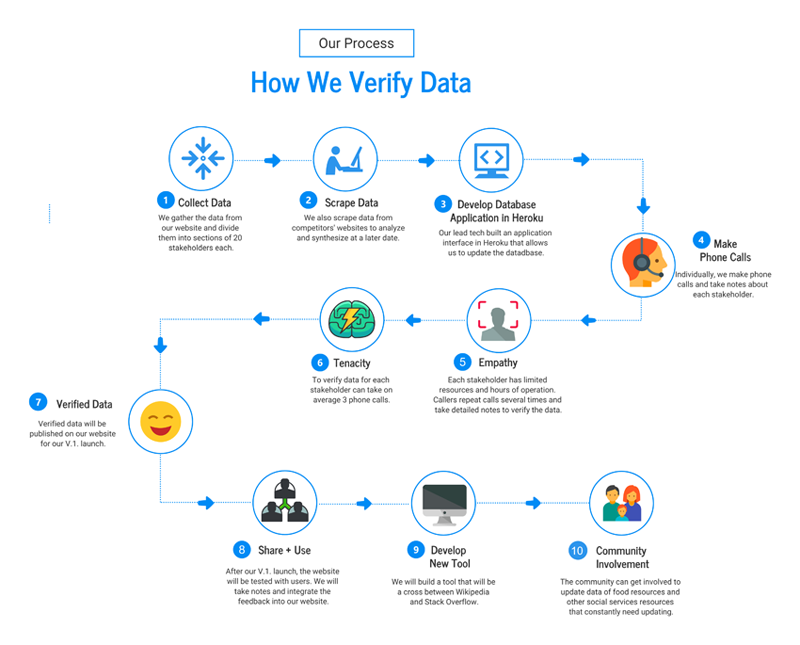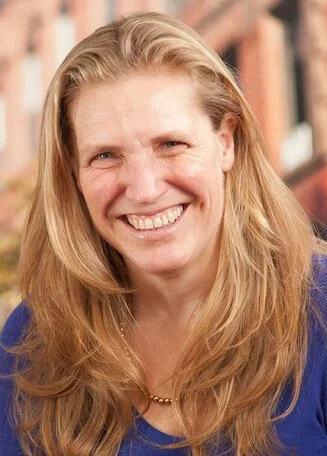Food Oasis: A New Resource Directory for Pantries and Meals
Photo by Maja Petric on Unsplash
Guest post by Jenny Mikesell
Lessons on User Research and Data Validation
Food belongs to the public. I am passionate about using technology to help address food insecurity, and I wanted to create a useful tool with good, up-to-date data. Bad data is worse than no data, especially for a person who is hungry.
When I joined the Food Oasis LA project, the website was live with a directory of local food resources, but the information in the database was old and inaccurate. My team began to reimagine this website for the individual seeking free food resources. Then COVID brought LA to a halt. The COVID-19 pandemic changed our perspective on the project: in addition to our efforts to connect individuals to food pantries, we saw the need for our platform to help connect food rescue organizations to food pantries that need food distributed. Our plan was to broaden our platform to focus on food rescue organizations in addition to individual food seekers, in order to make a greater impact through data, building a bridge between food rescue efforts, food pantries, and hungry people.
The Yellow Pages of Social Services cannot fall on the government. It’s on us. We are the ones who need to make the extra effort each day to take care of our community and our neighbors.
I took the spirit of welcoming anyone who wanted to walk this journey with us. Developers, designers, data analysts, and project managers volunteered with us. To date, we’ve had over 80 people join our project as volunteers, with a core team of five of us for most of the year. Organizing an all-volunteer team with zero budget has its advantages: our only limit is your team’s availability to commit time to the project.
User Research to Understand Food Insecurity
A minimal number of people on our team had first-hand experience with food insecurity, so I assigned each team member to visit a food pantry or soup kitchen to observe and learn. Only a couple of people returned with any results. I was asking them to enter a new realm and learn about a new world, outside their comfort zone. This is what I find so fascinating about user experience research and design: learning about people and translating their needs into tangible experiences.
As I continued to research, I uncovered many misconceptions about the causes of food insecurity.
Myth #1 - We do not produce enough food.
The world produces enough food for 10 billion people. There are currently 7.5 million people on the planet. In the US, almost half the food we produce is wasted. In 2019, the USDA’s Economic Research Service measured that food waste is estimated at 30-40 percent.
Myth #2 - Food is wasted because of neglect.
According to the USDA, food loss occurs for many reasons:
• spoilage—occurring at every stage of the production and supply chain
• problems during drying, milling, transporting, or processing
• damage by insects, rodents, birds, molds, and bacteria
• at the retail level, equipment malfunction
• over-ordering, and culling of blemished produce
• consumers also contribute when they buy or cook more than they need
Myth #3 - There is minimal effort to recover food.
The largest food rescue organization in Los Angeles County, FoodForward, rescues over 435,000 pounds of surplus produce each week from fruit trees, farmers markets and the Los Angeles Wholesale Produce Market with only volunteers. 100% of these fresh fruits and vegetables are donated to over 1,800 hunger relief agencies across eight counties in Southern California.
Myth #4 - The government isn’t paying attention.
Under Feed the Future, the U.S. Government’s Global Hunger & Food Security Initiative, research investments specifically designed for global food security have more than doubled, from $50 million in 2008 to $120 million in 2011.
Myth #5 - Food distribution problems are the only reason for food insecurity.
Food deserts, or geographical areas where grocery stores are located far from specific neighborhoods, are a major barrier for people trying to access healthy and affordable food. According to USDA data, there are 371 food deserts in California, and 85% of them are in urban areas.
“Between April and July 2020, 1 in 4 L.A. County households experienced food insecurity. That’s an estimated 873,000 households, making current levels of food insecurity in L.A. County much higher than pre-pandemic levels.“ —Public Exchange
I began reaching out to stakeholders in the community and doing user interviews to understand their needs: What would be the best way to focus our efforts? How could we feed more people and waste less food using technology? How could we get high-quality data and keep it up-to-date?
It is difficult to get interviews from stakeholders when your network is limited, so I started with the network I had. I had a great rapport with Pearson King at FoodForward; Pearson and I had been working a few months to establish a free farmer’s market at CalState LA. He provided answers to some of our foundational questions: How is food rescued? Where does it go? Who are the players? As he spoke, I created a large hand-written diagram to document the relationships between the key stakeholders: farmers, food distributors, food rescue organizations, food pantries, and individuals. Afterward, I designed an infographic to share what I learned with my team.
One of my teammates and I went to visit FoodForward’s cold warehouse. We spoke with Pearson King, the Community Leader, Michele Chase, and warehouse manager Luis Yepiz. Luis and his colleague were rescuing food starting at 4 AM and finishing at 2 PM via phone calls. No texts, no emails; just personal relationships and continual phone calls with farmers and food distributors. We learned that food rescue organizations operate in silos, preventing them from successfully coordinating with food pantries – which ultimately most hurts the individuals who need food. Identifying this pain point led us to narrow our focus to the user base of individuals seeking food, as we felt our platform would be most valuable for this group. User experience research doesn’t have to be extensive to be effective.
Validating Open Data
Food Oasis uses open data and open source code. Our goal is to share data with other organizations, to allow more organizations to cooperate, feed more people, and waste less food. Throughout our work, we have encountered numerous challenges with collecting, validating, and maintaining the data.
To collect our initial database of pantries and meals, we decided to scrape public databases. This would at least get us points on a map. After we looked at this data, we realized that it wasn’t always clear who provided the information or when it was last updated, so we needed to verify and validate this data before our users could trust it.
We knew we needed to create an easy way for volunteers to help us validate our database. We started by creating a volunteer training program, including a webinar to teach volunteers how to validate our data. Next, we built a web platform where each volunteer is assigned a list of organizations from our database to call, in order to validate each organization’s location, hours, and services. Each volunteer has their own dashboard to track their progress and can work at their own pace contacting organizations.
While we were training volunteers, another part of the team was designing and organizing our MVP, or minimum viable product: our website. We built the website with a focus on our validated data: we wanted to offer transparency to our users, so that they could trust our data to be accurate. When businesses started using the internet in the late 90s, every pixel was scrutinized. The web was treated with the same attention to the data as the The Yellow Pages, but over the years, standards began to slip. Still, Food Oasis remains committed to presenting good data.
Have We Fed Anyone Yet?
By focusing on accurate data, Food Oasis has helped make it easier for individuals in need to find food pantries and meals. Los Angeles didn’t have a comprehensive resource that maps all of the pantries and meal programs before Food Oasis. We’ve created a useful tool for food seekers, advocates, and food organizations working to alleviate food insecurity. We have had other successes along the way, as well. Our volunteers have validated over 850 listings. We have proven that 30% of the pantries in Los Angeles have temporarily or permanently closed since COVID. The Nutrition Department at the Department of Public Health asked for our database. We have on average 400 new users a day to the website. And finally, we expanded our project to include Northern California. There is a new website for Hawaii and one pending for Oregon.
A Proud Team
We are thrilled to have succeeded in building a resource for Los Angeles. Other tech teams have asked us to bring this resource to their communities. I'm always hopeful it is possible, but I'm practical to remind new teams that this project is all about the data. Building another website doesn't feed more people or reduce food waste. It’s the data that you need to focus on.
Keeping our database of social services resources updated is not a new challenge. We are experimenting with a lean approach based on user experience research, where we are recruiting volunteers to serve as liaisons between Food Oasis and the community by continuing to validate and improve our data. Our goal is to offer a shorter-term commitment that is still rewarding for volunteers. Though we ultimately decided to focus our platform on individual food seekers rather than food rescue organizations, we were able to partner with the team at FoodForward, who are starting to use our data to inform their work – amplifying the impact of our data validation efforts and helping connect rescued food to food pantries for distribution.
The information on the Food Oasis website belongs to the public. Food insecurity is a humanitarian issue that cannot be owned. Someday, we will figure out our business model in order to allow us to address challenges in the future. For now, we keep improving our software and recruiting volunteers to keep this information updated, to help get food to those who need it most.
About the Author
Jenny Mikesell is a UX/UI Researcher and Designer and she writes: “I was creating a mobile app for students. I wanted to connect the app to a resource for free food resources in LA. I came upon foodoasis.la created by a volunteer group, Hack for LA (a brigade of Code for America), created in 2016. The co-director encouraged me to take over the project and revive it. This definitely sounded a bit daunting. I was looking more for "an experience" to add to my portfolio. Knowing myself however, this would never be the case. When I do something, I put my heart into it.”
About Food Oasis LA
Food Oasis is creating a directory of updated food resources. There are countless groups helping to feed hungry Angelenos. But it’s difficult for those in need to find them because there’s no one source of updated info. We’re working to change that.
Food Oasis has 773 organizations in our database. Our team of volunteers updated the information for 333 organizations. Out of 333 organizations, 46 closed their doors and 66 closed for COVID. 37% of the organizations have closed their doors.
The primary goal of Food Oasis is to provide up-to-date information to Angelenos. We built a directory that connects anyone with hundreds of free food resources. Food Oasis presents reliable information on a user-friendly platform. This will reduce stress and uncertainty for food seekers. It will also demonstrate to our community the growing need of food donations in Los Angeles.
About Food Insecurity in Los Angeles
Access to enough food should be a basic right. Unfortunately, this is not the reality for millions of people in Los Angeles County. Before the Covid-19 pandemic, up to 1.4 million people in Los Angeles County faced food insecurity. Food insecurity is inconsistent with access to cheap and nutritious food. Los Angeles has the highest percentage of food insecurity in the nation.
Since COVID, 1.3 million people lost their jobs in Los Angeles County alone. This created a brand new vulnerable population. These are people who need food assistance for the first time. According to a study done by Feeding America in May 2020, over 500,000 Angelinos are newly food insecure.
Food pantries in the area are experiencing unprecedented demand. The demand for food assistance has almost doubled since the beginning of 2020. To compound matters, it is the hard work of volunteers that keeps pantries and meal programs open. The number of volunteers available to distribute food has diminished.







